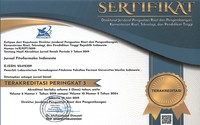Isolasi Dan Identifikasi Senyawa Kimia Monoterpen Dari Fraksi Etilasetat Daun Keji Beling (Strobilanthes crispa (L.) Blume) Yang Mempunyai Daya Sitotoksik
Abstract
Keywords
Full Text:
PDF (Bahasa Indonesia)References
Adibi, S. et al. (2017) ‘Induksi Tunas Keji Beling (Strobilanthes crispus L) Dengan Penambahan Kombinasi Naphtalen Acetic Acid (NAA) Dan 6-benzyl Amino Purin (BAP) Dalam Medium Cair’.
Buckley, J. P. (1966) ‘Pharmaceutical sciences (Np)’, Science, 151(3712), pp. 874–875. doi: 10.1126/science.151.3712.874.
Clarkson, C. et al. (2004) ‘In vitro antiplasmodial activity of medicinal plants native to or naturalised in South Africa’, Journal of Ethnopharmacology, 92(2–3), pp. 177–191. doi: 10.1016/j.jep.2004.02.011.
Dali, A. et al. (2017) ‘Uji Aktivitas Antioksidan Ekstrak Metanol Daun Pecah Beling (Strobilanthes crispus)’, Al-Kimia, 5(2), pp. 145–153.
Flowers, R. et al. (2006) ‘Best Practices in Microbiological Methodology.’, Aoac International, 12, p. 201.
Ghasemzadeh, A., Jaafar, H. Z. E. and Rahmat, A. (2015) ‘Phytochemical constituents and biological activities of different extracts of Strobilanthes crispus (L.) Bremek leaves grown in different locations of Malaysia’, BMC Complementary and Alternative Medicine. BMC Complementary and Alternative Medicine, 15(1), pp. 1–10. doi: 10.1186/s12906-015-0873-3.
Koay, Y. C. et al. (2013) ‘Chemical constituents and biological activities of strobilanthes crispus L’, Records of Natural Products, 7(1), pp. 59–64.
Koh, R. Y. et al. (2017) ‘Anticancer mechanisms of Strobilanthes crispa Blume hexane extract on liver and breast cancer cell lines’, Oncology Letters, 14(4), pp. 4957–4964. doi: 10.3892/ol.2017.6821.
Meyer, B. N., Ferrigni, N. R. and Putnam, J. E. (1982) ‘Brine shrimp: A convenient general bioassay for active plant constituents’, Planta Medica, 45(1), pp. 31–34. doi: 10.1055/s-2007-971236.
Nurraihana, H. and Norfarizan-Hanoon, N. A. (2013) ‘Phytochemistry, pharmacology and toxicology properties of Strobilanthes crispus’, International Food Research Journal, 20(5), pp. 2045–2056.
R. Hamidi, M., Jovanova, B. and Kadifkova Panovska, T. (2014) ‘Toxicological evaluation of the plant products using Brine Shrimp (Artemia salina L.) model’, Macedonian Pharmaceutical Bulletin, 60(01), pp. 9–18. doi: 10.33320/maced.pharm.bull.2014.60.01.002.
Rahmat, A. et al. (2006) ‘Anticarcinogenic Properties of Strobilanthes crispus Extracts and its Compounds in vitro’, pp. 47–49.
Setyawan, B. et al. (2016) ‘Pembuktian Ekstrak Daun Kejibeling Dalam Meningkatkan Sistem Imun Info Artikel Verification Of Kejibeling Leaf Extract In Improving The Immune System’, Kesehatan Masyarakat, 11(2).
Wijaya, H., Novitasari and Jubaidah, S. (2018) ‘Perbandingan Metode Ekstraksi Terhadap Rendemen Ekstrak Daun Rambut Laut (Sonneratia caseolaris L. Engl)’, Jurnal Ilmiah Manuntung, 4(1), pp. 79–83.
DOI: https://doi.org/10.33096/jffi.v8i1.721
Copyright (c) 2021 Jurnal Fitofarmaka Indonesia

This work is licensed under a Creative Commons Attribution-ShareAlike 4.0 International License.
Indexed by:
ISSN: 2356-0398 | e-ISSN: 2541-2329
Editor's Address:
Third Floor Pharmacognosy-phytochemistry laboratory building, Urip Sumoharjo road km. 5 Campus II UMI, Makassar, South Sulawesi, Indonesia
Phone: +6281524045514
Fax: +62411425619
E-mail: editorjfi@umi.ac.id

















.jpg)

